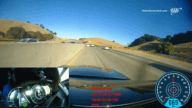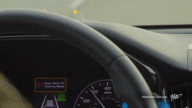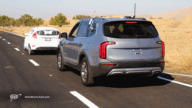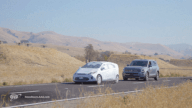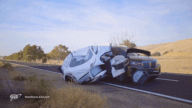New research finds 73% of performance issues are related to lane centering
PORTLAND, Ore., – Many new vehicles come equipped with active driving assistance systems that can steer the vehicle, control the speed, apply the brakes and keep the vehicle in its lane. New research from AAA finds that these systems don’t work well consistently. AAA automotive researchers found that over the course of 4,000 miles of real-world driving, vehicles equipped with active driving assistance systems experienced some type of issue every eight miles, on average. Researchers noted instances of trouble with the systems keeping the vehicles tested in their lane and coming too close to other vehicles or guardrails.
B-roll video of vehicle testing, a fact sheet, and the complete report are available.
AAA also found that active driving assistance systems, such as Adaptive Cruise Control and Lane Keeping Assistance, that combine vehicle acceleration with braking and steering, often disengage with little notice – almost instantly handing control back to the driver. This is a dangerous scenario if a driver has become disengaged from the driving task or has become too dependent on the system.
AAA recommends manufacturers increase the scope of testing for active driving assistance systems and limit their rollout until functionality is improved to provide a more consistent and safer driver experience. AAA also encourages drivers to learn about the systems and know their limitations.
Active driving assistance, classified as Level 2 driving automation on a scale of six (0-5) created by the SAE International, are advanced driver assistance systems (ADAS) that provide the highest level of automated vehicle technology available to the public today. This means for a majority of drivers, their first or only interaction with vehicle automation is through these types of systems, which according to AAA, are far from 100% reliable.
“Drivers may have a false sense of security that these active driving assistance systems work well. But AAA has repeatedly found that these systems do not perform consistently in real-world conditions,” says Marie Dodds, public affairs director for AAA Oregon/Idaho. “Manufacturers need to work toward more dependable technology, including improving lane keeping assistance and providing more adequate alerts.”
AAA tested the functionality of active driving assistance systems in real-world conditions and in a closed-course setting to determine how well they responded to common driving scenarios. On public roadways, nearly three-quarters (73%) of errors involved instances of lane departure or erratic lane position. While AAA’s closed-course testing found that the systems performed mostly as expected, they were particularly challenged when approaching a simulated disabled vehicle. When encountering this test scenario, in aggregate, a collision occurred 66% of the time and the average impact speed was 25 mph.
“Active driving assistance systems are designed to assist the driver and help make the roads safer, but the fact is, these systems are in the early stages of their development,” says Greg Brannon, director of automotive engineering and industry relations. “With the number of issues we experienced in testing, it is unclear how these systems enhance the driving experience in their current form. In the long run, a bad experience with current technology may set back public acceptance of more fully automated vehicles in the future.”
AAA’s 2020 automated vehicle survey found that only one in ten drivers (12%) would trust riding in a self-driving car. To increase consumer confidence in future automated vehicles, it is important that car manufacturers perfect functionality of active driving assistance systems as much as possible before deployment in a larger fleet of vehicles. AAA has met with industry leaders to provide insight from the testing experience and recommendations for improvement. The insights are also shared with AAA members and the public to inform their driving experiences and vehicle purchase decisions.
“It’s important for drivers to know that active driving assistance systems work some of the time, but not all of the time. These systems are designed to assist the driver, not replace the driver. It’s critical for drivers to still be attentive and focus on driving even when these systems are engaged,” adds Dodds.
Methodology
AAA conducted closed-course testing and naturalistic driving in partnership with the Automobile Club of Southern California’s Automotive Research Center and AAA Northern California, Nevada and Utah’s GoMentum Proving Grounds. Using a defined set of criteria, AAA selected the following vehicles for testing: 2019 BMW X7 with “Active Driving Assistant Professional”, 2019 Cadillac CT6 with “Super Cruise™”, 2019 Ford Edge with “Ford Co-Pilot360™”, 2020 Kia Telluride with “Highway Driving Assist” and 2020 Subaru Outback with “EyeSight®” and were sourced from the manufacturer or directly from dealer inventory. The 2019 Cadillac CT6 and the 2019 Ford Edge were evaluated only within naturalistic environments. For specific methodology regarding testing equipment, closed-course test scenarios and naturalistic routes, please refer to the full report here.
About AAA
AAA provides more than 60 million members with automotive, travel, insurance and financial services through its federation of 32 motor clubs and nearly 1,000 branch offices across North America. Since 1902, the not-for-profit, fully tax-paying AAA has been a leader and advocate for safe mobility. Drivers can request roadside assistance, identify nearby gas prices, locate discounts, book a hotel or map a route via the AAA Mobile app. To join, visit AAA.com.
AAA news releases, high resolution images, broadcast-quality video, fact sheets and podcasts are available on the AAA NewsRoom at NewsRoom.AAA.com.
Find local news releases at https://www.oregon.aaa.com/category/news-releases/




